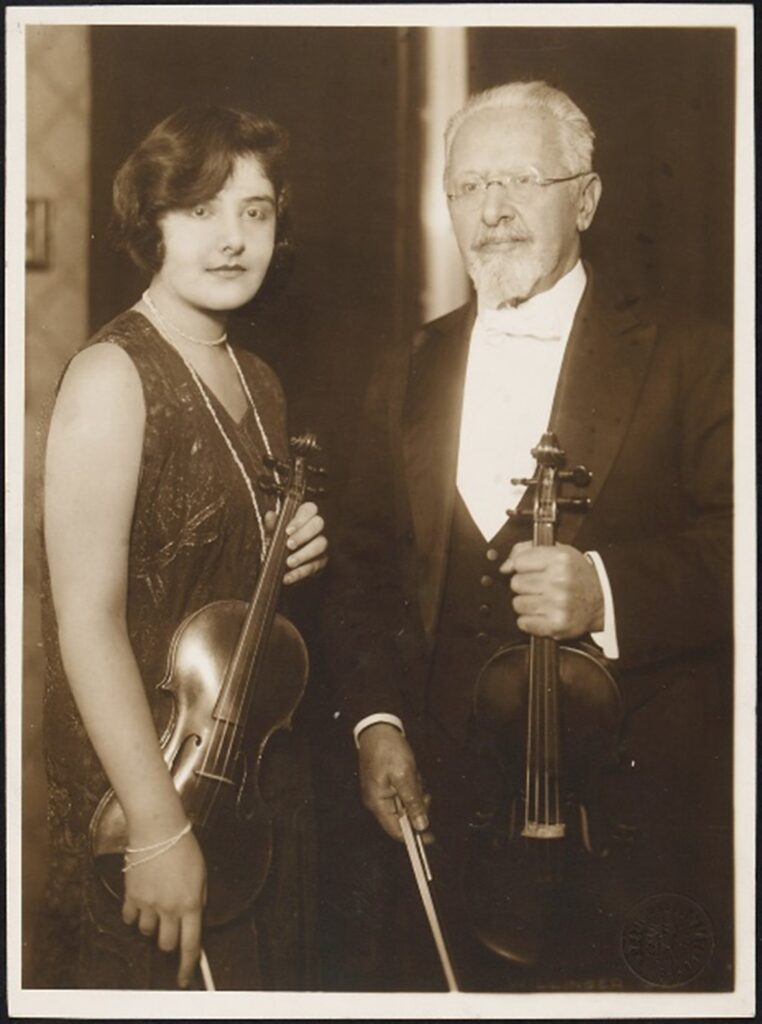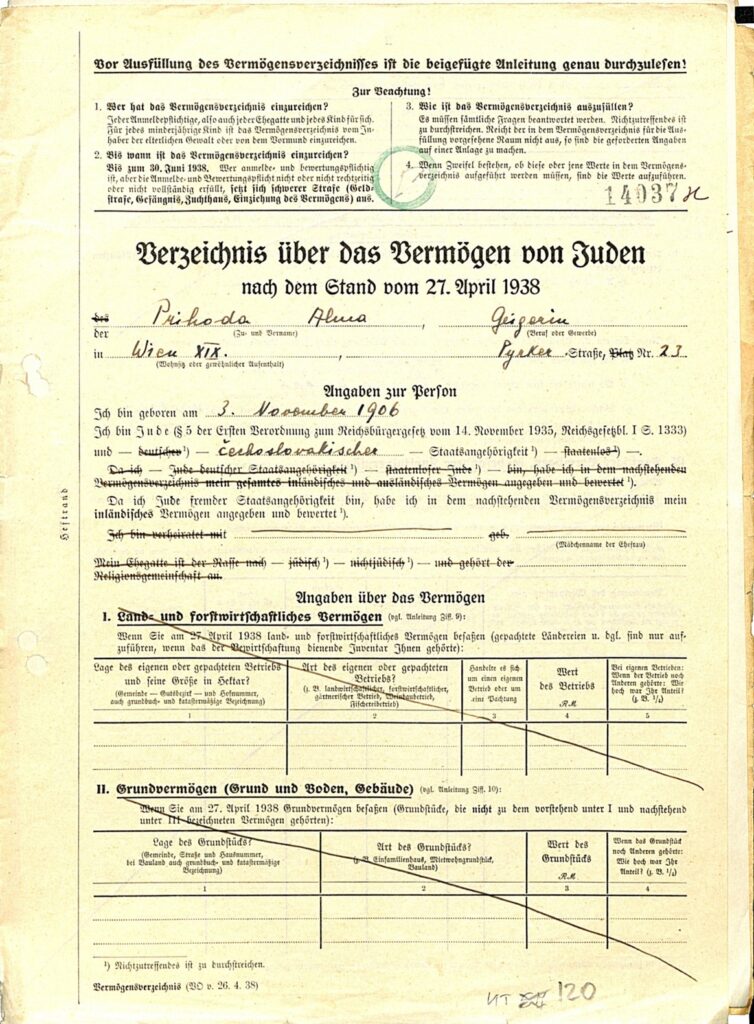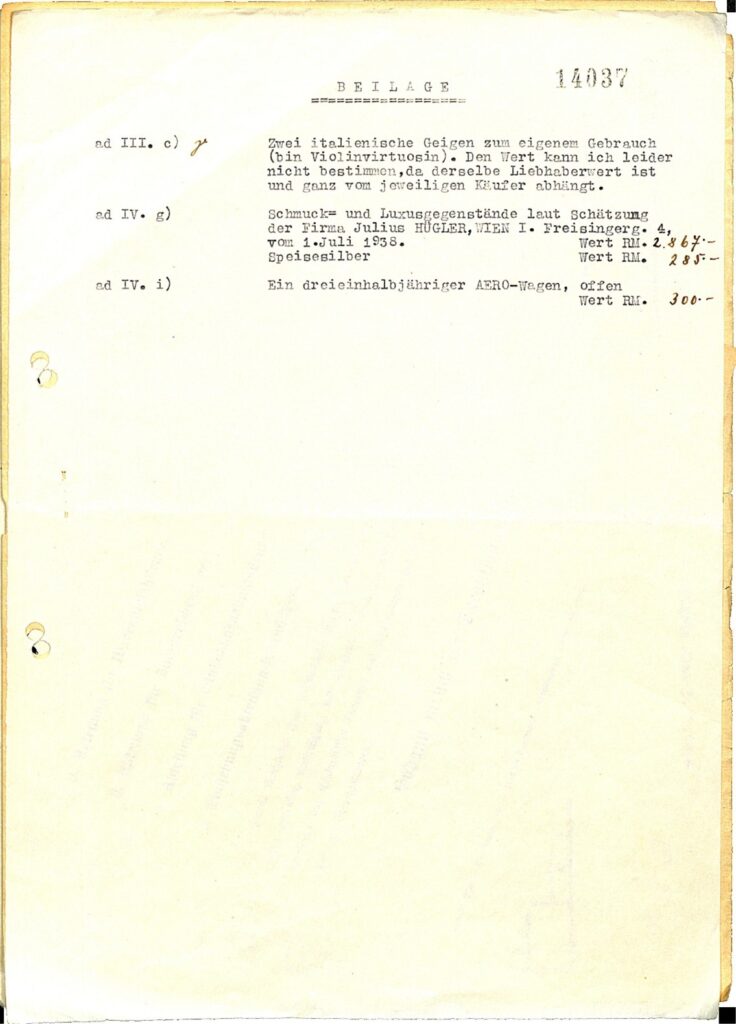“Both violins and all the jewellery are safe!”[1] – Rescuing Jewish property from National Socialism from a musician’s perspective – by Anna Rendl
1937 marked the 200th anniversary of the death of the famous Italian violin maker Antonio Stradivari, and the Austrian daily newspaper Der Wiener Tag published an article in which it drew attention to the enormous increase in instrument value that had recently been recorded, particularly for those instruments from the master’s “golden period”,[2] dating from 1700 to approximately 1725. If the instruments were in good condition, the newspaper wrote, they would not be sold for less than 160,000 shillings and prices would even climb as high as 400,000 shillings. Der Wiener Tag was a left-liberal newspaper and appeared for the last time on 12 March 1938, the day of the Anschluss, before it was prohibited by the Nazis. And on this day, one of the most famous Viennese owners of a “golden period” Stradivarius also performed for the last time for his Viennese audience before he had to leave the orchestra he had served for 57 years, being forced into early retirement. This was Hofrat Professor Arnold Rosé, concertmaster of the Vienna Philharmonic Orchestra. A member of the renowned Mahler-Rosé music family and founder of the legendary Rosé Quartett, Arnold Rosé was forced to leave his country penniless and at the last possible moment.
Some questions raised by historical research are: how could his valuable Stradivarius violin have been saved from the Nazis and their quest for “Aryanization”, and how could it have been taken out of the country?
After the Anschluss, according to the Nuremberg Laws, the Rosé family members were persecuted by the Nazis as so-called Volljuden (full Jews). On 26 April 1938, the Verordnung über die Anmeldung des Vermögens von Juden (Regulation on the Registration of the Assets of Jews) came into force. All persons defined as Jews under the Nuremberg Laws, as well as non-Jewish partners in so-called Mischehen (mixed marriages), were forced to declare their assets if they exceeded RM 5,000. Jews of foreign nationality had to declare their domestic assets.
The Rosé family led an exposed cultural life in the Viennese public eye and was generously and regularly mentioned in the local and international press. Also, Arnold’s daughter Alma, a violinist herself, played on a precious instrument made by Giovanni Battista Guadagnini in 1757. We see her here together with her father and the two famous instruments:

Even if no documents have yet been found which estimated the actual value of their violins in the months following the Anschluss, it can be assumed that each of the instruments exceeded the value limit of RM 5,000 for the declaration of assets many times over. The high risk, especially for well-known personalities such as the Rosés, of concealing such valuable items, which were repeatedly attributed to them in public, indicates a conscious decision and the planning of a strategy for saving them. The instruments, which are indispensable tools for musicians, were essential for the Rosés to be able to earn money in exile. Therefore, they were at the heart of the preparations for their emigration.
Arnold Rosé was the last member of his family to leave his home city of Vienna in 1939. His wife, Justine, sister of Gustav Mahler, had died in the late summer of 1938. Shortly afterwards, their son Alfred and his wife Maria Rosé-Schmutzer managed to emigrate, via the Netherlands, and by ship to New York, via Cincinnati, arriving in London, Ontario in Canada. Today, the Gustav Mahler – Alfred Rosé Collection is housed at the Western University of London, Ontario. Staying on in Vienna with her 75-year-old father was his daughter Alma. She managed to escape to London, UK in early 1939;Arnold followed her a few weeks later.[3]
Alma Rosé, a first-rate musician – violinist, conductor, ensemble leader, actress and founder of the famous women’s orchestra “Wiener Walzermädeln” – who toured with enormous success throughout Europe in the 1920s and early 1930s, is remembered today for her tragic fate, as the leader of the women’s inmate orchestra in Auschwitz-Birkenau. After her and her father’s successful escape, financial problems in exile became so overwhelming, due to the concert ban for European musicians in London, that Alma signed a contract for a two-month engagement at the Grand Hotel Central in The Hague – a venue where she and the “Wiener Walzermädeln” had often performed with great success.[4] More and more additional performance and concert opportunities opened up in the Netherlands, so Alma kept extending her stay. For some months, she led a successful concert life as a celebrated artist, then the enemies were at her heels again and war broke out. After the German occupation of the Netherlands, Alma’s escape attempt failed. With her last hope, she gave her Guadagnini to her lover Leonard Jongkees, together with a postcard saying “must not be lost”.[5] Alma Rosé was deported to Auschwitz-Birkenau on 18 July 1943.
Being recognised as a famous violinist upon her arrival in Auschwitz, she was appointed as leader of the already established women’s inmate orchestra by SS guard Maria Mandl from Vienna.[6] The orchestra had to play under inhumane conditions: in any weather outside near the camp gate; accompanying the work units with marching music; on Sundays in the main square providing some music to give a bit of hope to the inmates; or in the service of guards for their pleasure in private concerts.
Alma Rosé died suddenly in the infirmary in Auschwitz on 4 April 1944, probably as a result of food poisoning. The grotesque, tragic shift from promising international career to playing for time in an orchestra to survive in a Nazi death camp shows the infinite nature of music-making: surviving members of the orchestra, such as the cellist Anita Lasker-Wallfisch, told of Alma Rosé’s unbreakable determination to create something artistic from even the poorest musical knowledge and skills of the various orchestra musicians and the completely inadequate equipment of instruments and sheet music.
Her professional musical career before her deportation, which took Alma not only to classical concert stages, but also to a large number of variétés and vaudevilles in various formations, has so far only been partially reconstructed and reappraised. My PhD project on Alma Rosé’s professional career as a performing soloist and ensemble artist will close this gap (Alma Rosé und die „Wiener Walzermädeln“ – Die vergessene Karriere einer jüdischen Tonkünstlerin in Wien und Europa).
Although the artist Alma Rosé tragically did not survive, thanks to her, the Rosé’s two valuable instruments did. How could this have happened? By looking into the paperwork of the Rosé family, we can make an attempt at reconstructing how the violins were hidden from the Nazis.
Being in possession of a Czechoslovakian passport, because of her marriage to the Czechoslovakian violinist Váša Příhoda, whom she divorced in 1936, after the Anschluss Alma Rosé still had a number of special statuses in Vienna compared to Jews with German citizenship. She was not bound by the restrictive exit regulations, and used this to travel and explore opportunities for her and her father’s emigration. In this context, it was probably she who brought both instruments out of the country in autumn 1938.[7]
After the regulation on the registration of assets came into force in April 1938, registrations had to be made by 30 June 1938, and were processed by the Vermögensverkehrsstelle (Property Transaction Office), which was set up in the Ministry of Economics and Labour in May 1938. In her book Eigentum und Geschlecht: Jüdische Unternehmerfamilien in Wien (1900-1960), Austrian historian Sonja Niederacher points out the “exemplary functioning” the city of Vienna had compared to the Altreich (territories that were part of Germany before 1938), especially with regard to the expropriation of Jews and the speed with which it was carried out.[8]
Being a famous musician and hiding the ownership of such valuable instruments as a Stradivarius or Guadagnini violin, to save them from confiscation by the Nazis, was a considerable risk as in the event of false declarations of assets, the Jewish population was confronted with the threat of excessive penalties. Media reports such as those in Der Wiener Tag indicate a general awareness of the value of such instruments.
As part of the large-scale investigation into Jewish assets in Austria within the framework of the Austrian Historical Commission, historian Michael Pammer points out that wilful and negligent failure to declare assets was punishable by imprisonment of up to 10 years and forfeiture of assets, and that even attempts to do so were punishable.[9]
Pammer vehemently contradicts the assumption made in the ICEP: Report on Dormant Accounts of Victims of Nazi Persecution in Swiss Banks by the Volcker Commission in 1999 that the proportion of concealed Jewish assets was 44 to 52 percent of all assets actually held.[10] Her states that this significantly high rate assumed by the Volcker Commission of assets hidden in the declarations was justified in their report in particular by the normal rates of tax evasion in other countries assumed in other studies for the same period. They were reported at 65 percent for France and 20 percent for the Netherlands.[11] He argues that “the asset declarations were made under considerable pressure from a regime that was difficult to predict in its actions but obviously brutal, because the Jewish population was obviously intimidated by this and because the open threats of punishment alone went beyond the scope of what is usual in financial criminal law, apart from informal acts of persecution and assaults”[12]
The property tax declarations of 1938, which are today kept in the Austrian State Archives, are probably the most important source for all investigations and analyses of Jewish assets in Austria and were also used as a source for research into the whereabouts of the Rosé violins.[13]
Until now, it was assumed that Arnold Rosé had successfully concealed both instruments in his personal declaration of assets.[14] In several contexts this was stated for the two violins together, which creates uncertainty regarding the actual ownership of Alma Rosé’s violin.[15] However, her obvious possession of the Guadagnini violin can be seen as important indication of her own legal ownership, which would have meant that she would have had to declare this violin in a personal declaration of assets under her own name.
The files on property declarations held in the Austrian State Archives in alphabetical order can be regarded as highly complete.[16] But only the asset declarations of Arnold Rosé and his daughter-in-law, Alfred’s wife Maria Rosé-Schmutzer, can be found under the letter R.
The missing link here is Alma Rosé’s married name and her Czechoslovakian citizenship, which became a crucial element for her successful first escape from the Nazis. Looking under the letter P for her married name “Prihoda” – written in this variant, not Příhoda or Příhodová as would be the regular feminine form of Czech surnames – her own declaration has recently been found and provides new impetus for thinking about the strategies for rescuing Jewish assets from the Nazis.


The supplement to Alma’s declaration lists both violins; not with the indication of the names of their creators – which would have immediately revealed their true value – but as “two Italian violins for personal use” with Liebhaberwert (collector’s value). This legal definition was particularly cleverly chosen here as a tactic for concealing the true value. The Liebhaberwert is determined by the interest of a limited group of collectors who value other special features of the item in addition to its usual use, such as its rarity or association with a prominent person. Different buyers would therefore pay vastly different prices, which is how Alma explained that she could not determine the true value of the instruments.
It is also striking that the total value of Alma’s declaration of assets – without specifying the value of the violins – did not exceed RM 5,000 and therefore no declaration would actually have been obligatory. Also, her declaration, as well as Arnold’s, was submitted after the deadline had expired, and thus maybe was not examined so thoroughly as the others which arrived on time.
Thanks to Alma’s courageous efforts, both instruments went successfully into exile. The Rosés emphatically refused to sell them, even when hunger became permanent. The violins were Arnold’s and his daughter’s lifeline, as they were their working instruments. Only Alma’s imprisonment hindered her from earning money as the outstanding musician she was. Arnold was heartbroken when he heard that Alma had died in a never-heard of camp named Auschwitz. He lost all will to live, sold the Stradivarius and died shortly after.
Arnold Rosé never set foot on Austrian soil again, even though, according to his colleague Friedrich Buxbaum, principal cellist of the Vienna Philharmonic until 1938 and member of the “Rosé Quartett”, also forced into exile in London, it was his wish to go back to Vienna on the eve of his death.[17] But his Stradivarius is miraculously back in Austria, not stolen but legitimately acquired by the Austrian National Bank, which sponsors the Alma Rosé Prize today. The “ex-Viotti––ex-Rosé” Stradivarius, crafted in 1718, is named after its most respected owners, Giovanni Battista Viotti and Arnold Rosé himself — both epoch-making violinists and violin teachers in their day. The instrument is part of the Austrian National Bank’s collection of historical string instruments.
How Alma Rosé’s Guadagnini made its way back to her father in 1945 is not entirely clear. Arnold Rosé subsequently sold it to one of his students.[18] Currently, the violin belongs to a private owner.
With this short essay, I wish to remember Alma Rosé, the courageous daughter, who not only took responsibility for her own violin, but also for her father’s, and concealed both instruments’ true value and brought them safely into exile. They were meant as the Rosés’ tools of freedom guarantees of a new life and career, but tragically it ended differently.
As a case study, Alma Rosé’s story will lead to deeper research on female contributions during the Holocaust, saving Jewish lives and property from the Nazi regime.
[1] Quote from the first letter of Alma Rosé to her brother Alfred from London, UK, from 19 March 1939, original German text: “Beide Geigen und der ganze Schmuck sind draußen”. Letter preserved in the Gustav Mahler – Alfred Rosé Collection, Music Library, University of Western Ontario.
[2] Friedmann, Ernst. ‘Was ist eine Stradivari Geige wert?’, in Der Wiener Tag, 8 March 1937, 4. Source: ANNO/Österreichische Nationalbibliothek.
[3] Rathkolb, Oliver. ‘Arnold Rosé – A Musical Life in a Variety of Contexts that Deserves Renewed Attention, in Raggam-Blesch, Michaela / Sommer, Monika / Uhl, Heidemarie. Only the Violins Remain. Alma & Arnold Rosé (Vienna: Haus der Geschichte Österreich, 2019), 12.
[4] Newman, Richard. Alma Rosé, Vienna to Auschwitz (Pompton Plains: Amadeus Press, 2000), 128.
[5] Raggam-Blesch, Michaela / Sommer, Monika / Uhl, Heidemarie. Only the Violins Remain. Alma & Arnold Rosé (Vienna: Haus der Geschichte Österreich, 2019), 208.
[6] Uhl, Heidemarie. ‘Arnold Rosé – A Musical Life in a Variety of Contexts that Deserves Renewed Attention, in Raggam-Blesch, Michaela / Sommer, Monika / Uhl, Heidemarie. Only the Violins Remain. Alma & Arnold Rosé (Vienna: Haus der Geschichte Österreich, 2019), 36.
[7] Raggam-Blesch, Michaela / Sommer, Monika / Uhl, Heidemarie. Only the Violins Remain. Alma & Arnold Rosé (Vienna: Haus der Geschichte Österreich, 2019), 122.
[8] Niederacher, Sonja. Eigentum und Geschlecht. Jüdische Unternehmerfamilien in Wien, 1900-1960 (Vienna: Böhlau 2012), 142.
[9] Pammer, Michael. Jüdisches Vermögen in Wien 1938 (Vienna: Oldenbourg, 2003), 44.
[10] Pammer, Michael. Jüdisches Vermögen in Wien 1938 (Vienna: Oldenbourg, 2003), 47.
[11] Pammer, Michael. Jüdisches Vermögen in Wien 1938 (Vienna: Oldenbourg, 2003), 46.
[12] Pammer, Michael. Jüdisches Vermögen in Wien 1938 (Vienna: Oldenbourg, 2003), 47, translation by the autor.
[13] Raggam-Blesch, Michaela / Sommer, Monika / Uhl, Heidemarie. Only the Violins Remain. Alma & Arnold Rosé (Vienna: Haus der Geschichte Österreich, 2019), 120.
[14] https://wph-live.s3.amazonaws.com/media/filer_public/83/0d/830d2035-53e6-451f-b460-a4b7fb4122ee/ns_mayr_ex_rose_de_v02.pdf
[15] Raggam-Blesch, Michaela / Sommer, Monika / Uhl, Heidemarie. Only the Violins Remain. Alma & Arnold Rosé (Vienna: Haus der Geschichte Österreich, 2019), 120.
[16] Pammer, Michael. Jüdisches Vermögen in Wien 1938 (Vienna: Oldenbourg, 2003), 34.
[17] Buxbaum, Friedrich. ‘Arnold Rosé’s letzte Stunden’, in Wiener Zeitung, 10 September 1946, 3. (Source: ANNO/Österreichische Nationalbibliothek)
[18] Raggam-Blesch, Michaela / Sommer, Monika / Uhl, Heidemarie. Only the Violins Remain. Alma & Arnold Rosé (Vienna: Haus der Geschichte Österreich, 2019), 208.
